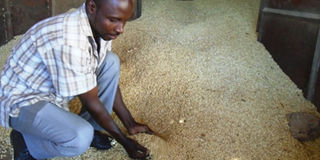Boosting productivity with maize milling

Nviiri cleans his maize grain before taking it for milling.
Maize is grown in many parts of Uganda, both as a food and cash crop. Because of the increased demand for maize by-products and consumption of posho, maize growing has become lucrative.
However, many farmers are not benefiting much in terms of profits because they sell maize grains instead of adding value to the produce and selling maize flour.
Unlike such farmers, Daniel Nviiri, 40, has discovered gold in adding value to his maize.
A resident of Naminya village in Njeru Municipality, Buikwe District, Nviiri says he discovered that he could earn more from his maize by milling it into maize flour, six years ago.
Starting out
“I had grown maize for more than 10 years and I was selling grains to businessmen who paid me some little money. After sometime, I realised that these businessmen were making more profits than I did by simply milling the maize,” Nviiri says. In 2010, Nviiri planted two acres of maize from which he got 3,200 kilogrammes of maize.
He says by then, a kilo of maize grain was going for Shs300 so by selling it in grain form he would earn about Shs960,000. However, he explains, he milled it and sold a kilo of maize flour at Shs1,700 thus getting about Shs3m. But, Nviiri explains, when he subtracted all the costs like milling and transport, he remained with about Shs2.5m.
From that time, he realised that adding value to maize brings more profits, Nviiri has since then never sold his maize in grain form.
The farmer and businessman says currently, he has milled 3,000 kilogrammes of maize flour.
Because of the acute shortage of maize on the market due to last year’s prolonged drought, Nviri says the price for a kilogramme of maize grain has shot to Shs1,550 up from Shs1,050 in January. This trend, he says, is good for him as a farmer as it will make him get super-normal profits.
This has in turn led to a rise in the retail prices of maize flour, with a kilogramme of grade number one going for between Shs2,800 and Shs3,000 while grade number one and a half is at between Shs2,400 and Shs2,500 a kilo.
Because of the increased prices of posho, Nviiri says, consumers now prefer to buy grade number one and half because it is less expensive. With the fluctuation in prices of posho, Nviiri says he stores his produce until the prices go up then he mills and sells it at a higher price.
Did you know
Maize, also known as corn, is a large grain plant first domesticated by indigenous peoples in southern Mexico about 10,000 years ago.
Maize has become a staple food in many parts of the world, with total production surpassing that of wheat or rice. However, not all of this maize is consumed directly by humans. Some of the maize production is used for corn ethanol, animal feed and other maize products, such as corn starch and corn syrup.
Challenges
The biggest challenge he faces is the high milling costs as a result of high electricity costs.
Currently, they charge Shs300 for milling a kilo of grade one maize flour from Shs150 while number one and a half is milled at Shs200 per kilo.
The high milling costs reduce his profit margin. Since he also buys from other farmers, Nviri is affected by the high cost of maize grains.
Also, the long dry spells lead to crop failure since he depends on rain to grow his crop.
Market
He sells his produce to schools and other institutions plus produce stores in urban centres like Kampala, Mukono, Kampala and others. However, he also sells to individual buyers. Nviri says he sometimes takes the flour to the buyers, who occasionally pay him at delivery or later. In a week, he sells between 40 and 50 bags of flour.
Process
1.He harvests the maize when it is dry and threshes it using a maize thresher.
2.The grains are then dried on tapelines to ensure that they don’t get soiled.
3.Then it is sieved to remove the chaff from grains.
4.It is then taken to the maize mill where it is milled according to the required grade.
5. It is then packed in bags of 10 kg or 50 kg.
Nviiri says he sells his produce under the brand name “Bugerere Maize millers”




